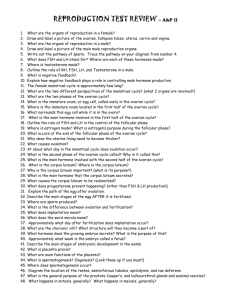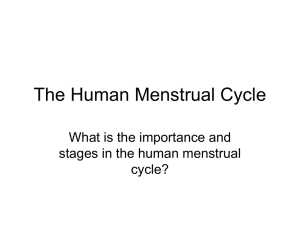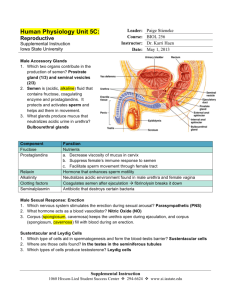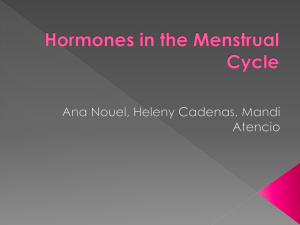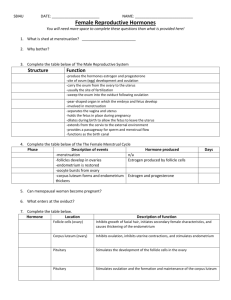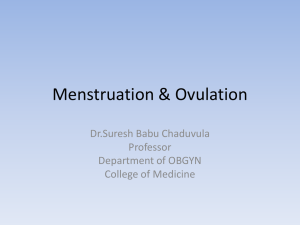L4,5- Physiology of ovarian & uterine cycle
advertisement
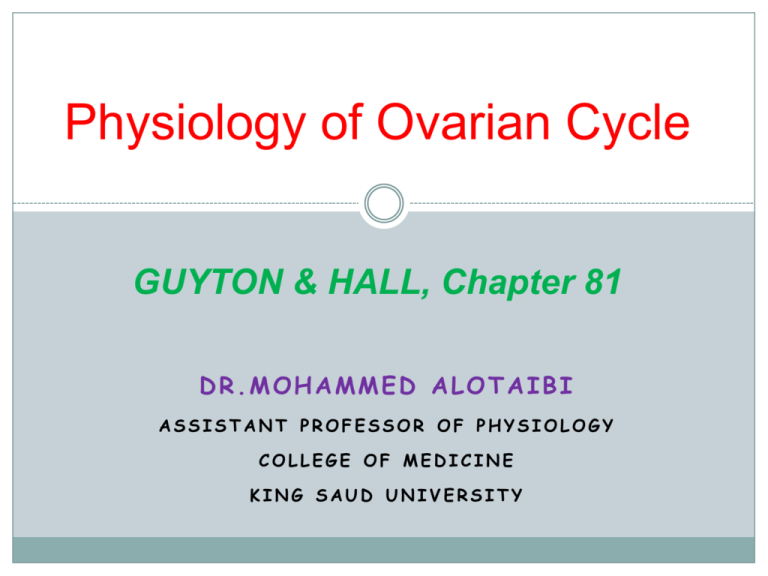
Physiology of Ovarian Cycle GUYTON & HALL, Chapter 81 DR.MOHAMMED ALOTAIBI ASSISTANT PROFESSOR OF PHYSIOLOGY COLLEGE OF MEDICINE KING SAUD UNIVERSITY Objectives By the end of this lecture, you should be able to: 1. List the hormones of female reproduction and describe their physiological functions 2. Describe the changes that occur in the ovaries during the menstrual cycle 3. Describe the hormonal control of the development of ovarian follicles, mature oocytes and corpus luteum 4. Recognize the pituitary-ovarian-axis and the changes that occur in the ovaries leading to ovulation Physiologic Anatomy of the Female Sexual Organs Monthly Menstrual Cycle Normal repr. Years of female → Monthly rhythmical changes in the rates of secretion of female hormones & corresponding physical changes in the ovaries & other sexual organs. Duration of the cycle averages 28 days (20-45 days). There are 2 results of the female sexual cycle: 1. Single ovum is released from the ovaries each month 2. Uterine endometrium is prepared for implantation of the fertilized ovum. Gonadotropic hormones and their effects on the ovaries The ovarian changes during the sexual cycle depend completely on FSH & LH secreted by AP. Both FSH and LH stimulate their ovarian target cells by combining with highly specific receptors leading to an increase in the cells rates of secretion, growth & proliferation. GnRH Ovarian Cycle Luteal Phase (Postovulatory) Follicular Phase (Preovulatory) Ovulation Ovarian follicle growth “Follicular” phase of the ovarian cycle: o In female child each ovum is surrounded by single granulosa cell sheath called primordial follicle which provides nourishment for the ovum & secrete oocyte maturation-inhibiting factor which keeps the ovum in its primordial state o After puberty, AP secretes FSH and LH resulting in ovum to increase in size & growth of additional layers of granulosa cells of some follicles known as primary follicles Ovarian follicle growth During the first few days of the monthly female sexual cycle there is an increase secretion of FSH and LH o FSH increase is slightly more & earlier than LH which causes the acceleration of growth of many primary follicles each month. o There is proliferation of the granulosa cells to many layers. o The ovary interstitium collects in several layers outside the granulosa cells to form a second mass of cells called theca The theca is divided into 2 layers: 1. theca interna 2. theca externa, aromatase Ovarian follicle growth Few days after proliferation & growth of the follicles, the granulosa cells secrete follicular fluids that contain high concentration of estrogen. This fluid accumulates to form antrum within the mass of the granulosa cells Ovarian follicle growth The early growth of the primary follicle up to the antral stage is under FSH stimulation only. Then there is accelerated growth of the follicle to larger follicle called vesicular follicle (Graffian) caused by: 1. estrogen secreted into the follicle caused the granulosa cells to increase FSH receptors which causes positive feedback effect 2. both estrogen & FSH combine to promote LH receptors on the original granulosa cells in addition to FSH stimulation, allowing more rapid increase in follicular secretion 3. the increasing estrogen from the follicle plus increasing LH from the AP causes proliferation of the follicular theca cells & increase their secretion Ovarian follicle growth - The antral follicles begin to grow. The ovum enlarges & remains embedded at one pole of the granulosa cells of the follicle During all the reproductive years of adult life, between about 13 and 46 years of age, 400 to 500 of the primordial follicles develop enough to expel their ova—one each month. - The remaining follicles (5 to 11) undergo atresia or involute Ovulation LH is necessary for final follicular growth and ovulation: 2 days before ovulation rate of LH secretion ↑ to 6-16 fold & peaks about 16 hrs before ovulation. Ovulation LH is necessary for final follicular growth and ovulation: - FSH also ↑ 2 to 3 fold & acts synergistically with LH to cause swelling of the follicle before ovulation. - LH has specific effect on the granulosa cells & theca cells converting them to progesteronesecreting cells → rate of estrogen secretion ↓ about 1 day before ovulation while progesterone secretion begin to ↑ Initiation of ovulation Large quantity of LH causes rapid secretion of progesterone from the follicle. Within a few hours 2 events occur which are necessary for ovulation: 1) the theca externa begins to secrete proteolytic enzymes & causes weakening of the wall resulting in swelling of the follicle & degeneration of the stigma 2) rapid growth of new blood vessels into the follicle wall & prostaglandins are secreted into the follicular tissue. Ovulation It occurs 14 days after the onset of menstruation in 28 days cycle. During ovulation, stigma protrudes & fluids ooze from the follicle & the stigma ruptures allowing more viscous fluid outward carrying with it the ovum surrounded by mass of granulosa cells called corona radiata Corpus Luteum corpus albicans 7-8 days after ovulation ~ 1.5 cm in diameter The granulosa cells with the theca cells are called corpus luteum. Corpus Luteum ‘’Luteal’’ phase of the ovarian cycle - After expulsion of the ovum from the follicle, the remaining granulosa & theca interna cells change to lutein cells & become filled with lipid inclusions giving them yellowish appearance. - The granulosa cells in corpus luteum form large amount of progesterone & estrogen. The theca cells form mainly androgens which are converted by granulosa cells into female hormones. Corpus Luteum Luteinizing function of LH: 1- Extrusion of the ovum from the follicle. 2- Change of granulosa and theca interna cells into lutein cells. 3- Secretion of progesterone & estrogen from the corpus luteum. - If pregnancy occurs, the hCG from the placenta acts on the corpus luteum to prolong its life for 2 to 4 months of pregnancy Corpus Luteum Involution of the corpus luteum and onset of the next ovarian cycle: 1- Estrogen & progesterone from corpus luteum (luteal phase) have strong negative feedback effect on AP to inhibit the secretion of FSH & LH. 2- The lutein cells secrete small amounts of inhibin which inhibit secretion of FSH by AP. ↓ FSH & LH & loss of these hormones >> complete degeneration of corpus luteum (involution) 3- Around 26th days of normal sexual cycle & after involution of corpus luteum, sudden cessation of estrogen, progesterone & inhibin removes the negative feedback inhibition of the AP & allowing ↑ secretion of FSH & LH again. Corpus Luteum FSH & LH initiate the growth of new follicles, beginning a new ovarian cycle. Physiology of Uterine (Endometrial) Cycle GUYTON & HALL, Chapter 81 DR.MOHAMMED ALOTAIBI ASSISTANT PROFESSOR OF PHYSIOLOGY COLLEGE OF MEDICINE KING SAUD UNIVERSITY Objectives By the end of this lecture, you should be able to: 1. Describe the normal menstrual cycle 2. Discuss the structural changes that occur in the endometrium during the menstrual cycle and explain how these changes are hormonally controlled 3. Recognize the phases of the menstrual cycle 4. Describe the physiology of menopause and the disorders of menstruation Monthly endometrial cycle and menstruation It is associated with the monthly cyclical production of estrogens & progesterone by the ovaries in the lining of the uterus GnRH Uterine (endometrial) Cycle Proliferative phase (estrogen Phase) (Preovulatory) Secretory phase (progestational phase) Ovulation (Postovulatory) Proliferative phase (estrogen phase) - At the beginning of each cycle, most of the endometrium has been desquamated by menstruation. After menstruation only thin layer of the endometrial stroma remains & the deeper portions of the glands &crypts of the endometrium under the influence of estrogens, the stromal cells & epithelial cells proliferate rapidly. - The endometrial surface re-epitheliazed within 4-7 days after the beginning of menstruation. Before ovulation the endometrium thickness increase, due to increase numbers of stromal cells &progressive growth of the glands & new blood vessels. Uterine (endometrial) Cycle At the time of ovulation, the endometrium is 3-5 mm thick. The endometrial glands, cervical region secrete a thin, stringy mucus which helps to guide sperm in the proper direction from the vagina into the uterus. Secretory phase (progestational phase) After ovulation, progesterone & estrogen are secreted in the later part of the monthly cycle by the corpus luteum. Estrogen causes slight proliferation in the endometrium& progesterone causes marked swelling & secretory development of the endometrium. The glands increase in tortuosity, excess secretory substances accumulate in the glands. - Stromal cells cytoplasm increase lipid &glycogen deposits in the cells & blood supply to the endometrium increases and become more tortuous. 1 week after ovulation, endometrium thickness is 5-6 mm. Uterine (endometrial) Cycle -The secretory changes prepare the endometrium (stored nutrients) for implantation of the fertilized ovum .Uterine secretions called “uterine milk” provide nutrition for the dividing ovum. The trophobastic cells on the surface of the implanted ovum begin to digest the endometrium & absorb endometrial stored substances. Menstruation -If the ovum is not fertilized, about 2 days before the end of the monthly cycle, the corpus luteum in the ovary suddenly involutes and the ovarian hormones (estrogens and progesterone) decrease to low levels of secretion, - Necrosis is initiated in the endometrial blood vessels, due to: 1) vasospasm 2) decrease nutrients to the endometrium 3) loss of the hormonal stimulation - The mass of desquamated tissue & blood plus the contractile effects of prostaglandins all initiate contractions which expel the uterine contents. Uterine (endometrial) Cycle Menstruation - In normal menstruation, about 40 ml of blood + 35 ml of serous fluid are lost. The menstrual blood is normally non-clotting due to the presence of fibrinolysin. -Within 4 to 7 days after menstruation, the loss of blood ceases & the endometrium become re-epithelialized. Leukorrhea during menstruation: During menstruation, leukocytes are released with the necrotic material & blood so the uterus is highly resistant to infection during menstruation as protective mechanism. Summary Menopause and the Disorders of Menstruation Menopause At the age of 40 to 50 years, the sexual cycle becomes irregular, ovulation fails to occur & the cycle ceases The loss of estrogens causes marked physiological changes in the function of the body including: 1. “hot flushes” characterized by extreme flushing of the skin; 2. psychic sensations and dyspnea; 3. irritability; 4. fatigue; 5. anxiety; 6. occasionally various psychotic states 7. decreased strength and calcification of bones throughout the body. Abnormalities of secretion by the ovaries Hypogonadism-Reduced Secretion by the Ovaries: Can result from poorly formed ovaries, lack of ovaries, or genetically abnormal ovaries that secrete the wrong hormones because of missing enzymes in the secretory cells. - When ovaries are absent from birth or when they become nonfunctional before puberty, female eunuchism occurs. Hypersecretion by the Ovaries. Disorders of Menstruation Amenorrhea: Is absence of menstrual period either Primary amenorrhea in which menstrual bleeding has never occurred. Secondary amenorrhea cessation of cycles in a woman with previously normal periods, causes: Pregnancy (is the most common cause) Emotional stimuli and changes in the environment. Hypothalamic diseases ( GnRH pulses) Pituitary disorders Primary ovarian disorders and various systemic disease. Menorrhagia: Refer to abnormally heavy or prolonged bleeding. Hypomenorrhea: Refer to scanty flow. Dysmenorrhea: Painful menstruation (cramps due to accumulation of prostaglandins in the uterus and treatment with inhibitors of prostaglandin synthesis).


